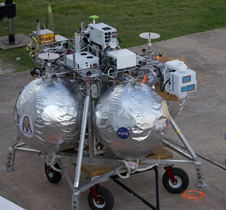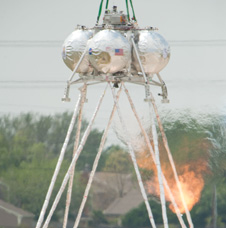Feature
Text Size
Morpheus/ALHAT To Track To Kennedy Space Center Before Targeting Otherworldly Options
07.19.12

While tethered tests at JSC have enabled the testing of guidance, navigation and control without the risk of a crash, free flights at KSC will demonstrate the fully integrated flight capability of the vehicle. Photo credit: NASA/Robert Markowitz
Americans are not the only ones joining in the very common summer activity of a road trip. The Morpheus lander, a rocket-powered vehicle being fostered under the Advanced Exploration Systems portfolio, is heading to Kennedy Space Center (KSC) in Florida mid-July for technology gains that are far from common in the spaceflight realm: real-time hazard detection and avoidance capability by a spacecraft.Morpheus will rendezvous in the sunshine state with the Autonomous Landing and Hazard Avoidance Technology (ALHAT) Project, a complex suite of instruments that will hitch a ride on Morpheus to put their sensors to the test.
“The ALHAT program was designed to do real-time hazard avoidance and precision landing and on any planetary surface,” said Dr. Chirold Epp, ALHAT project manager. “We have been testing on helicopters and airplanes, but we can’t really demonstrate everything we’re trying to do without duplicating a landing trajectory, and Morpheus provides that for us.”
Morpheus progressed exponentially during the hot-fire tests and tethered flights conducted in the field west of Johnson Space Center’s Building 14. In fact, you may have seen this bubbly lander hovering in the horizon or firing its green propulsion system of liquid oxygen and liquid methane.
“With the testing that we’ve done here at JSC, we’ve been trying to characterize the performance of the vehicle under a tethered flight envelope,” said Dr. Jon Olansen, project manager of the Morpheus Project. “The tether basically provides a risk reduction to the vehicle; it gives us a margin of safety to be able to do testing and understand how the vehicle operates under a variety of conditions. But that only gets us so far.”
For the vehicle to blossom further, free flights are needed with sufficient range potential. KSC will provide that with a test site at the KSC Shuttle Landing Facility (SLF), simulating a planetary surface with rocks, craters and slopes north of the SLF runway. The new target landing site will put the Morpheus Project and accompanying ALHAT Project through the paces necessary to prove the systems are capable of handling destinations much more exotic than the continental United States. After all, the prototype craft will be doing something virtually unheard of for vehicles going beyond the confines of low-Earth orbit—choosing its very own safe zone for landing in about 10 seconds flat and landing safely at this determined spot.
“It’s never been done,” Epp said. “We’ve never landed of the moon or Mars with real-time hazard detection and avoidance. Most of the Mars missions use air bags. They go where they go, they roll them and they stop … whatever comes, comes.”

A Morpheus/ALHAT laser test conducted on May 24 showcases the integrated vehicle and its potential for other worlds. Photo credit: NASA/ Kris Kehe
But rather than leave fate in the hands of other worlds and their potential obstacles, Morpheus and ALHAT intend for the vehicle to monitor the hazards and intelligently respond to them.“We’re tailorable to the vehicle depending on what people build,” Epp said. “They could require better detection or less detection, but we’ve taken the most conservative approach. We figure any vehicle can tolerate a basketball (about 30 centimeters). So we want to detect everything 30 centimeters and larger, every hole 30 centimeters and deeper, and avoid those things and go land in the safe spots.”
To do that, the ALHAT sensors scan the target area upon approach. Within 4 seconds, it gets a full elevation map reading that shows where all the hazards are located.
“Then in the next 4 to 6 seconds, it will determine where the safe sites are and tell the vehicle to divert and go there,” Epp said. “We’ll guide it the rest of the way down, again by tracking a feature. We’re leading the technology in high-speed, high-volume processing necessary to get this performance.”
These upcoming summer tests at KSC, though, would not have been possible without the initial work that’s been done most visibly at JSC, as well as other centers. Morpheus and ALHAT are wonderful examples of the partnerships that exist within the agency, since seven of the 10 NASA centers contribute time, energy and resources to both.
“There’s a lot of work that has been done here,” Olansen said. “ALHAT’s been working since 2006 in technology development activities. Specific parts that are now accumulated into Morpheus actually began a few years ago. The intent of Morpheus was to tie all those things together into an integrated flying vehicle.”

Morpheus completes its first hot-fire test in the field west of JSC’s Building 14 on April 14, 2011. Photo credit: NASA/Robert Markowitz
“Controlling a rocket vehicle requires very complex guidance, navigation and control,” Epp said. “We have very high-tech sensors, and by getting them here and on Morpheus, we’ve learned a lot. So integrating all that, getting all that together, proving we can make it work, has been just tremendous. We’ve made major strides in the past month.”The vehicle will be better equipped to answer the challenge of alien worlds with the free flights at KSC.
“At some point you’ve got to take things out of the laboratory and get them into a relevant environment and do the integration associated with them,” Olansen said. “So that’s really what we’ve been about—taking that next step. The technologies offer promise, but capabilities offer solutions. The idea is to advance those to the point where they’re then available for other NASA programs or other entities to use for their spaceflight missions.”
The vehicle will reside at KSC until testing is complete, and then return to JSC. Future operations and development work needed for the high-altitude flights will also be done in Houston with the groups that have been vital in bringing Morpheus and ALHAT this far along on the technology roadmap.
“The teams that are working this put in an amazing amount of time and effort,” Olansen said. “It’s hard to get them to go home sometimes. They believe in what they’re doing, they believe in the benefits to NASA, and are really looking forward to getting down to KSC and conducting these tests.”
catherine.e.williams@nasa.gov
281-483-3317